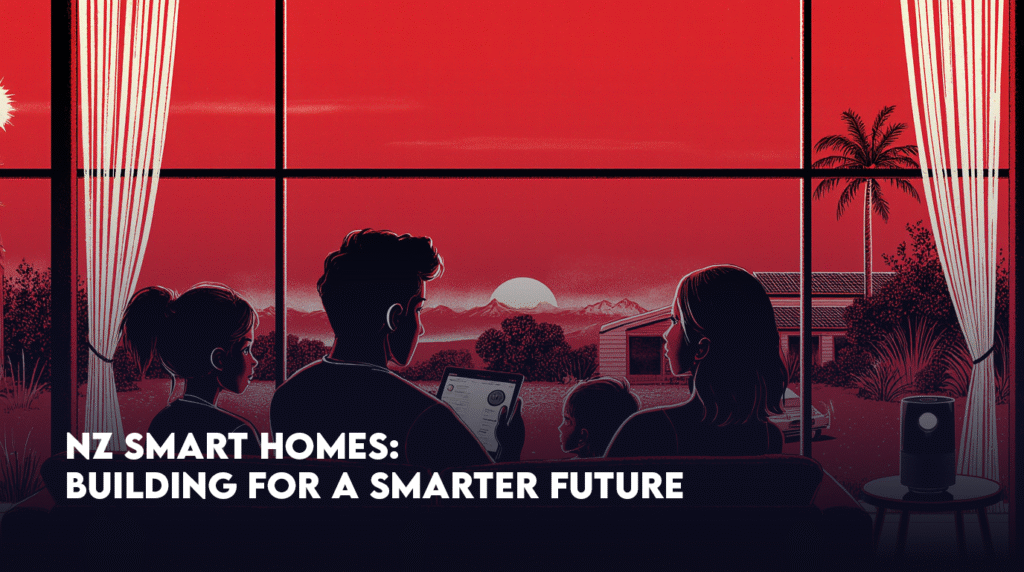The “Why”: Value in a Connected World
The demand for smart homes isn’t just a fleeting trend; it’s driven by very real needs and desires of homeowners:
- Unmatched Convenience and Lifestyle Enhancement: Effortless Living: Imagine lights that turn on when you enter a room and off when you leave, heating that adjusts based on the weather forecast, or blinds that close automatically at sunset. These automations simplify daily life and give homeowners back precious time.
Remote Control: Whether it’s turning on the air conditioning on the drive home from work, checking if the garage door is closed while on holiday, or letting a friend in while you’re away, the ability to control home functions from anywhere is incredibly powerful.
- Significant Energy Efficiency and Cost Savings: Reduced Power Bills: New Zealanders are increasingly conscious of power costs. Smart energy management systems allow homeowners to monitor their energy consumption in real-time, identify energy-hungry appliances, and optimize usage.
Sustainable Living: Integrating smart tech helps reduce a home’s carbon footprint. Automated heating and cooling, smart lighting, and integration with solar and battery storage systems contribute to a more sustainable and environmentally friendly household, aligning with NZ’s broader sustainability goals.
- Enhanced Security and Peace of Mind: Proactive Protection: Smart security systems go beyond traditional alarms. Video doorbells let you see who’s at your door from anywhere, smart locks provide keyless entry and track who enters and leaves, and integrated CCTV systems can offer advanced features like motion detection and even facial recognition.
Deterrence and Monitoring: The visible presence of smart security deters potential intruders. For homeowners, the ability to remotely monitor their property offers significant peace of mind, especially when they’re away.

The “What”: Key Technologies for Smarter Living
When we talk about integrating technology into NZ construction, we’re focusing on several key areas that deliver tangible benefits:
- Home Automation Systems: This is the central nervous system of a smart home, allowing different devices and systems to communicate and work together seamlessly. Centralized Control: Homeowners can manage everything from a single app, a wall-mounted tablet, or even voice commands. This eliminates the need for multiple remotes and complex interfaces.
Smart Lighting: Automated Scheduling: Lights can turn on/off at specific times, mimicking occupancy when you’re away. Dimming & Colour Control: Adjusting brightness and even the colour temperature of lights can create different moods and improve well-being. Motion Sensors: Lights activate only when a room is occupied, saving energy.
Climate Control (Smart Thermostats & Heating): Learning Capability: Modern smart thermostats can learn a homeowner’s preferences and adjust heating/cooling schedules automatically. Zone Control: Different areas of the house can be set to different temperatures, preventing energy waste in unused rooms. Remote Access: Adjusting the home’s temperature from your phone before you arrive ensures comfort while saving energy when no one is home.
Automated Blinds and Curtains: Light & Privacy Management: Automatically open in the morning, close at sunset, or adjust throughout the day to optimize natural light and maintain privacy. Energy Regulation: Can help insulate windows, reducing heat loss in winter and heat gain in summer.
- Energy Management Systems (EMS): Given New Zealand’s focus on sustainability and energy costs, EMS are becoming incredibly important.
Smart Meters & Real-Time Monitoring: These devices track electricity consumption in real-time, providing homeowners with detailed insights into where their energy is going. This data helps identify energy vampires (appliances using power unnecessarily).
Solar Integration & Battery Storage:: Optimized Usage: An EMS can intelligently manage power flow from solar panels, directing it to active appliances, charging a home battery, or feeding excess back into the grid. Backup Power: Home batteries provide resilience during power outages and can store energy during off-peak hours for use during more expensive peak times.
Smart Appliance Control: Connecting appliances to an EMS allows for automated scheduling (e.g., running dishwashers during off-peak electricity hours) or remote power-down to avoid standby consumption.
- Smart Security Systems: Moving beyond basic alarms, these systems offer layers of intelligent protection.
Smart Door Locks:
Keyless Entry: Access codes, fingerprint readers, or even smartphone unlocking eliminate the need for physical keys.
Remote Access: Grant temporary access to visitors or service providers from anywhere.
Activity Logs: Track who enters and leaves the home and when.
Video Doorbells:
Visitor Identification: See and speak to visitors from your phone, even when you’re not home.
Motion Detection: Receive alerts for activity near your front door.
Integrated CCTV & Surveillance:
High-Definition Monitoring: Clear video feeds accessible remotely.
AI Analytics: Advanced cameras can distinguish between people, animals, and vehicles, reducing false alarms.
Event-Triggered Recording: Record only when motion or specific events are detected, saving storage space.
Connected Alarm Systems: Modern alarms integrate with other smart home components, for example, flashing lights or unlocking doors in an emergency.
Also Read: Navigating Construction Budgeting: 10 Mistakes to Avoid
The “How”: Integrating Smart Tech into NZ Construction
Integrating these technologies seamlessly isn’t as simple as just “plugging things in.” It requires thoughtful planning and a shift in approach for builders.
- Early Planning and Design Integration: Think Smart from Day One: The best smart homes are designed with technology in mind from the initial blueprint stage. This means planning for data cabling (Cat6 or fiber optic to key areas), power outlets in strategic locations, and network infrastructure.
Future-Proofing: While technology evolves rapidly, laying down robust network cabling (the “backbone”) ensures the home can adapt to new devices and systems years down the line without needing costly rewiring.
- Robust Network Infrastructure: Wired First Approach: While Wi-Fi is essential, relying solely on it can lead to unreliable performance, especially with many devices. Hardwiring critical components like TVs, security cameras, and main control panels provides stability and speed.
Mesh Wi-Fi Systems: For wireless devices, a strong and comprehensive Wi-Fi network using mesh technology ensures seamless coverage throughout even large NZ homes, eliminating dead spots.
- Interoperability and Ecosystem Choice: Open Standards: Encourage systems that use open standards (like Zigbee, Z-Wave, or Matter) rather than proprietary systems. This allows different brands of devices to communicate with each other, giving homeowners more flexibility.
Integrated Platforms: Advise clients on choosing a central hub or platform (e.g., Control4, Savant, Homey, or even simpler systems like Google Home/Amazon Alexa for basic integration) that can manage various devices cohesively.
- Education and Client Consultation: Understand Client Needs: Don’t just install tech for tech’s sake. Sit down with clients to understand their lifestyle, priorities (convenience, energy saving, security), and budget. Tailor the smart home solution to their specific requirements. Show Value and ROI: Educate clients on the long-term benefits beyond initial costs, explain how energy savings can offset installation costs, or how enhanced security provides invaluable peace of mind.
Ease of Use: A smart home isn’t smart if it’s too complicated to use. Ensure the interface is intuitive and easy for the homeowner to manage on a daily basis.
- Training and Ongoing Support: Handover Training: Provide comprehensive training to homeowners on how to use their new smart home system. A detailed user manual and a walk-through are crucial. After-Sales Support: Smart home systems, like any technology, may require troubleshooting. Offering ongoing support or connecting clients with reliable integrators builds trust and ensures satisfaction.
The Future of NZ Construction is Smart
For construction companies in New Zealand, embracing smart home technology isn’t just about keeping up; it’s about leading. It’s about building homes that are not only structurally sound and aesthetically pleasing but also intelligent, efficient, and responsive to the needs of their inhabitants.
By focusing on thoughtful planning, robust infrastructure, and clear communication, the NZ construction industry can deliver homes that offer true smarter living, adding immense value to clients and contributing to a more sustainable and convenient future for all New Zealanders. This approach will differentiate your business in a competitive market and position you as a forward-thinking leader in modern residential construction.
